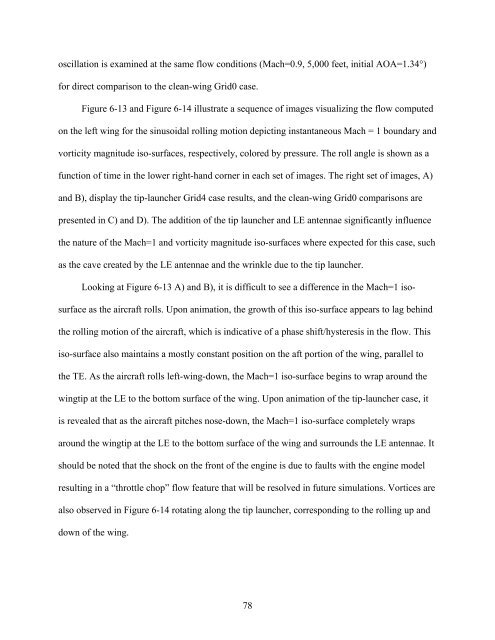university of florida thesis or dissertation formatting template
university of florida thesis or dissertation formatting template
university of florida thesis or dissertation formatting template
You also want an ePaper? Increase the reach of your titles
YUMPU automatically turns print PDFs into web optimized ePapers that Google loves.
oscillation is examined at the same flow conditions (Mach=0.9, 5,000 feet, initial AOA=1.34°)<br />
f<strong>or</strong> direct comparison to the clean-wing Grid0 case.<br />
Figure 6-13 and Figure 6-14 illustrate a sequence <strong>of</strong> images visualizing the flow computed<br />
on the left wing f<strong>or</strong> the sinusoidal rolling motion depicting instantaneous Mach = 1 boundary and<br />
v<strong>or</strong>ticity magnitude iso-surfaces, respectively, col<strong>or</strong>ed by pressure. The roll angle is shown as a<br />
function <strong>of</strong> time in the lower right-hand c<strong>or</strong>ner in each set <strong>of</strong> images. The right set <strong>of</strong> images, A)<br />
and B), display the tip-launcher Grid4 case results, and the clean-wing Grid0 comparisons are<br />
presented in C) and D). The addition <strong>of</strong> the tip launcher and LE antennae significantly influence<br />
the nature <strong>of</strong> the Mach=1 and v<strong>or</strong>ticity magnitude iso-surfaces where expected f<strong>or</strong> this case, such<br />
as the cave created by the LE antennae and the wrinkle due to the tip launcher.<br />
Looking at Figure 6-13 A) and B), it is difficult to see a difference in the Mach=1 iso-<br />
surface as the aircraft rolls. Upon animation, the growth <strong>of</strong> this iso-surface appears to lag behind<br />
the rolling motion <strong>of</strong> the aircraft, which is indicative <strong>of</strong> a phase shift/hysteresis in the flow. This<br />
iso-surface also maintains a mostly constant position on the aft p<strong>or</strong>tion <strong>of</strong> the wing, parallel to<br />
the TE. As the aircraft rolls left-wing-down, the Mach=1 iso-surface begins to wrap around the<br />
wingtip at the LE to the bottom surface <strong>of</strong> the wing. Upon animation <strong>of</strong> the tip-launcher case, it<br />
is revealed that as the aircraft pitches nose-down, the Mach=1 iso-surface completely wraps<br />
around the wingtip at the LE to the bottom surface <strong>of</strong> the wing and surrounds the LE antennae. It<br />
should be noted that the shock on the front <strong>of</strong> the engine is due to faults with the engine model<br />
resulting in a “throttle chop” flow feature that will be resolved in future simulations. V<strong>or</strong>tices are<br />
also observed in Figure 6-14 rotating along the tip launcher, c<strong>or</strong>responding to the rolling up and<br />
down <strong>of</strong> the wing.<br />
78
















